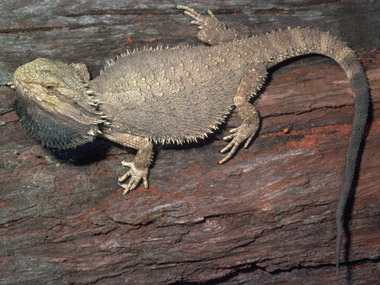Salmonellosis is frequently classified as a foodborne disease because contaminated food, mainly of animal origin, is the predominant mode of transmission.1 In the United States, “exotic pets” such as reptiles have become popular and reptile-associated salmonellosis has emerged as a public health problem.2-5 In Australia, although accurate figures on pet reptile ownership and reptile-associated disease are difficult to obtain, the risk to human health must be considered.
International evidence suggests reptile-associated Salmonella infections are more likely to be associated with invasive disease, more commonly lead to hospitalisation and more frequently involve infants and younger children than do other Salmonella infections.4 The particular susceptibility of children to disease transmission from reptiles kept in the family home may be due to greater exposure to the contaminated reptile and greater host vulnerability.5 Much of the available evidence regarding risk in children comes from case–control studies conducted in the US.2,5 There have also been numerous reports of sporadic cases of invasive disease and hospitalisation of children and infants with salmonellosis linked to reptiles.3 A fatal case of S. Rubislaw meningitis in a 3-week-old baby was linked to a pet water dragon in England.6
It has been estimated that 90% of reptiles are colonised with Salmonella, which is shed intermittently in their faeces.7 Such high rates of colonisation suggest Salmonella are commensal organisms of the gastrointestinal tracts of these animals.4 There are over 2500 Salmonella serotypes, with most (including S. Rubislaw) belonging to S. enterica subspecies I.8 Serotypes of S. enterica subspecies I cause most Salmonella infections in humans and other warm-blooded animals. By contrast, over half of the S. enterica serotypes reported from reptiles in Australia belong to subspecies IIIa, IIIb and IV, which are rare in humans (NEPSS, unpublished data).
Salmonella carried by reptiles can be transmitted either through handling a reptile, or indirectly by contact with an object contaminated by a reptile or its faeces.5 The droppings of free-roaming reptiles may result in widespread contamination of the home environment. The hands of younger children are readily contaminated, while infants may be indirectly infected via their parents or siblings. Ultimately, bacteria are transferred to the mouth and ingested. Hand washing may not eliminate the risk of infection. As the entire surface of a reptile may be contaminated, so may be the clothes and skin (beyond the hands) of the handler.9
We suspect the Australian public may not be familiar with reptile-associated salmonellosis. In the US, public health authorities have advocated the prohibition of the sale or gifting of reptiles without written point-of-sale education being provided by pet-store owners.3 Australian states and territories vary in their regulation of reptile ownership. NSW pet stores are not permitted to buy or sell reptiles or even to have them on their premises, whereas commercial reptile dealing occurs in Victoria, SA, the Northern Territory and ACT.10 In the ACT, eastern bearded dragons are classified as Category A reptiles (licence exempt), under the Nature Conservation Act 1980, and can be kept by individuals without prior experience in keeping such animals. Within the ACT there is no compulsion for pet stores, breeders or reptile keepers to inform prospective reptile owners or members of the public of possible risks to human health associated with reptile ownership or contact. We recommend that owners and prospective owners of reptiles be better informed of the risks to human health, particularly the threat to children.
Lessons from practice
Some Salmonella serotypes that occupy specific environmental niches infect humans through environmental sources rather than foods.
Clinicians managing a young child with salmonellosis should ask parents or guardians about contact with household pets, including lizards, snakes, turtles and fish.
Investigating individual cases of unusual infections can shed light on novel and evolving public health risks.
Reptile-associated salmonellosis may become a more significant issue for medical practitioners and public health authorities in Australia.
Parents and guardians should be advised about the risks (including invasive salmonellosis) that pet reptiles may pose to infants and young children.
- 1. Heymann DL, editor. Control of communicable diseases manual. 18th ed. Washington, DC: American Public Health Association, 2008.
- 2. Ackman DM, Drabkin P, Birkhead G, Cieslak P. Reptile-associated salmonellosis in New York State. Pediatr Infect Dis J 1995; 14: 955-959.
- 3. Centers for Disease Control. Reptile-associated salmonellosis — selected states, 1998–2002. MMWR Morb Mortal Wkly Rep 2003; 52: 1206-1209.
- 4. Mermin J, Hutwagner L, Vugia D, et al. Reptiles, amphibians, and human Salmonella infection: a population-based, case-control study. Clin Infect Dis 2004; 38 Suppl 3: S253-S261.
- 5. Wells EV, Boulton M, Hall W, Bidol SA. Reptile-associated salmonellosis in preschool-aged children in Michigan, January 2001–June 2003. Clin Infect Dis 2004; 39: 687-691.
- 6. Ward L. Fatal neonatal Salmonella rubislaw infection in household with pet reptile in England. Euro Surveill 2000; 4: pii=1663.
- 7. Ward L. Salmonella perils of pet reptiles. Commun Dis Public Health 2000; 3: 2-3.
- 8. Grimont FAD, Weill F-X, editors. Antigenic structure of the Salmonella serovars. 9th ed. Paris: World Health Organization, Institut Pasteur, 2007.
- 9. Warwick C, Lambiris AJ, Westwood D, Steedman C. Reptile-related salmonellosis. J R Soc Med 2001; 94: 124-126.
- 10. NSW Government Department of Environment, Climate Change and Water. Buying and caring for reptiles. http://www.environment.nsw.gov.au/wildlifelicences/BuyingAndCaringForReptiles.htm (accessed May 2010).






We are grateful for the assistance of the Microbiological Diagnostic Unit, University of Melbourne, for the serotyping of ACT isolates, and the ACT Government Analytical Laboratory for processing of ACT environmental isolates. We also thank Peter Robertson for supplying the image of the eastern bearded dragon. The OzFoodNet enhanced foodborne disease surveillance program is funded by the Australian Government Department of Health and Ageing.
None identified.